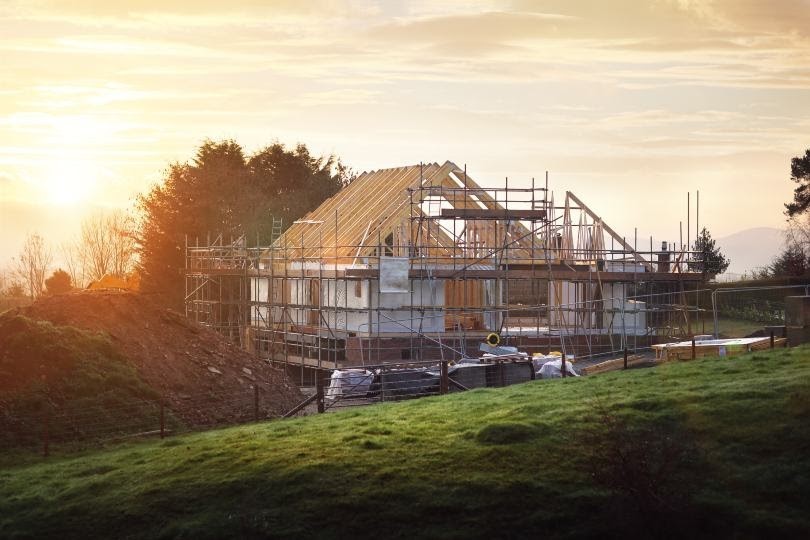Enjoy a 5.99% 30-Year Fixed Rate on select U.S. homes*! Limited time offer. Explore All Promotions
Should You Buy or Build Your Next House?

When you start looking for your next house, don’t assume you’re limited to existing homes. Building a new home is more attainable than you may think.
Neither option is right for everyone, however. Let’s look at some of the benefits and drawbacks of building a house vs. buying.
Is It Cheaper to Build or Buy a House?
Both options have variables that make answering this question hard to answer.
- An older home could need expensive repairs sooner than a newly built home.
- Tacking a lot of upgrades onto your new home build can substantially increase your overall cost to build.
It might not be much of a difference, anyway. According to the National Association of Realtors, the median sale price of an existing home in June 2021 was $363,300. According to the U.S. Census Bureau, the median sale price of a new home in June 2021 was $361,800.
Pros for Buying an Existing Home
- You’re likely to move in quicker. You can typically move into a resale home 30 to 45 days after your purchase offer is accepted, according to BHGRE Life. Building a new home usually takes three to six months, according to realtor.com. However, new-home builders typically offer new homes that are move-in-ready too.
- Some have fantastic character. Older resale homes can be loaded with charming features from past eras like artisan woodworking, doors, floors, cabinetry, and decorative ceilings.
- They are usually located in established neighborhoods. You can get a good feel for a neighborhood that’s already established and the nearby amenities.
- There’s usually mature landscaping and trees. The outside is more likely to have established plantings, shade-providing trees, stone paths, and play areas.
Cons of Buying an Existing Home
- They have a history. If you aren’t the first homeowner of a house, you may feel like you are moving into someone else’s history.
- They are getting older. At roughly 5,500 years old, the Knap of Howar in Scotland is believed to be among the oldest homes in existence today. According to a 2019 American Community Survey, 52.5% of owner-occupied homes in the U.S. were built in 1979 or before, including 12.3% of homes built in 1939 or earlier.
- They’ll need updating. Somewhere between brand new and charmingly old, is a point where a home seems outdated. Upgrades that can add up include: appliances, carpet, flooring, window treatments, lighting, and plumbing fixtures. Average cost to remodel in 2020 was $47,000, according to Homeadvisor.
- Hazards and problems could exist. Lead-based paint and plumbing pipes may be present in homes built before 1978. Asbestos materials can also be inside walls. Undetected structural issues, termite damage, mold, and substandard plumbing can carry costly fixes.
- You’re moving into someone else’s dirt. There’s bound to be remnants of the previous occupants. At a minimum, you should change out the old toilet seats and furnace/AC filters, cleaning dryer ducts, and refrigerator coils when you move in.
Pros for Building a New Home
- Everything is new. New fixtures and equipment lessens the chance of costly, unexpected breakdowns and failures. It’s also just… clean.
- It’s more energy-efficient. New construction homes are built with more energy-efficient materials, equipment, and appliances. This saves you money over time.
- You establish the baseline for its history. You determine the baseline history of your new home, introducing its first pets, kids, laughs, and gatherings.
- There are usually great amenities. Many new communities offer amenities such as community spaces, parks and playgrounds, swimming pools, and event spaces.
Cons for Building a New Home
- They are usually located in newer areas of town. New construction homes tend to be built farther away from urban areas. In some cases, common nearby amenities such as grocery stores, restaurants, gas stations, and service businesses may just be going up, too.
- Optional upgrades can add to the initial home cost. It’s tempting to upgrade one thing, then another, and yet another in the planning phase. Brookfield Residential is a new-home builder that offers move-in ready homes complete with designer-selected options and finishes included in the price. Brookfield Residential has price transparency for all homes they build.
- You’ll have to wait until the house is finished. That is, unless you buy a move-in ready newly built home that many new-home builders offer. If you’re having it built, it is likely to take more than a few months. An upside of building is that you aren’t as likely to compete with other potential buyers as happens when buying existing homes.
Ready to Learn More About Building Your Next Home?
A new construction home is no longer limited to those with high incomes. Brookfield Residential builds an array of single-family houses, condos, and duplexes to fit nearly any budget. Brookfield is an award-winning, master-planned communities developer. Contact us today to explore Brookfield Residential communities.
